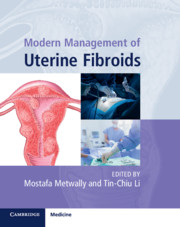Book contents
- Modern Management of Uterine Fibroids
- Modern Management of Uterine Fibroids
- Copyright page
- Contents
- Contributors
- Foreword
- Chapter 1 Pathophysiology of Uterine Fibroids
- Chapter 2 Evaluation of Uterine Fibroids Using Two-Dimensional and Three-Dimensional Ultrasonography
- Chapter 3 Ulipristal and Other Medical Interventions for Treatment of Uterine Fibroids
- Chapter 4 The Role of Magnetic Resonance Imaging in the Management of Fibroids
- Chapter 5 Fibroids and Fertility
- Chapter 6 Fibroids and Reproduction
- Chapter 7 Open Myomectomy
- Chapter 8 Laparoscopic and Robotic Myomectomy
- Chapter 9 Principles and Technique of Laparoscopic Myomectomy
- Chapter 10 Uterine Fibroids
- Chapter 11 Total Laparoscopic Hysterectomy for the Fibroid Uterus
- Chapter 12 Hysteroscopic Resection of Submucosal Fibroids
- Chapter 13 Modern Management of Intramural Myomas
- Chapter 14 Outpatient Myomectomy
- Chapter 15 Vaginal Hysterectomy with Fibroids
- Chapter 16 Leiomyosarcoma
- Chapter 17 MRI-Guided Ultrasound Lysis of Fibroids
- Chapter 18 Embolization for the Management of Uterine Fibroids
- Chapter 19 Uterine Fibroids in Postmenopausal Women
- Appendix: Video Captions
- Index
- References
Chapter 15 - Vaginal Hysterectomy with Fibroids
Published online by Cambridge University Press: 10 October 2020
- Modern Management of Uterine Fibroids
- Modern Management of Uterine Fibroids
- Copyright page
- Contents
- Contributors
- Foreword
- Chapter 1 Pathophysiology of Uterine Fibroids
- Chapter 2 Evaluation of Uterine Fibroids Using Two-Dimensional and Three-Dimensional Ultrasonography
- Chapter 3 Ulipristal and Other Medical Interventions for Treatment of Uterine Fibroids
- Chapter 4 The Role of Magnetic Resonance Imaging in the Management of Fibroids
- Chapter 5 Fibroids and Fertility
- Chapter 6 Fibroids and Reproduction
- Chapter 7 Open Myomectomy
- Chapter 8 Laparoscopic and Robotic Myomectomy
- Chapter 9 Principles and Technique of Laparoscopic Myomectomy
- Chapter 10 Uterine Fibroids
- Chapter 11 Total Laparoscopic Hysterectomy for the Fibroid Uterus
- Chapter 12 Hysteroscopic Resection of Submucosal Fibroids
- Chapter 13 Modern Management of Intramural Myomas
- Chapter 14 Outpatient Myomectomy
- Chapter 15 Vaginal Hysterectomy with Fibroids
- Chapter 16 Leiomyosarcoma
- Chapter 17 MRI-Guided Ultrasound Lysis of Fibroids
- Chapter 18 Embolization for the Management of Uterine Fibroids
- Chapter 19 Uterine Fibroids in Postmenopausal Women
- Appendix: Video Captions
- Index
- References
Summary
Vaginal hysterectomy is the surgical removal of the uterus through the vagina. The first reported vaginal hysterectomy, performed by Themison of Athens, dates back to 50 BC, and the procedure is also known to have been performed by Soranus of Greece in AD 120 [1]. There are also sporadic reports dating to the sixteenth century but with questionable outcomes. In 1670, Percival Willoughby, a male midwife, reported a case of a 46-year-old peasant, Faith Haworth, who was carrying a heavy load when her uterus prolapsed completely and, agitated by this, she pulled it out as far as possible and cut it off using a knife. The bleeding apparently settled soon after and she lived to old age albeit with a fistula [2]. The first detailed reports of planned vaginal hysterectomy were for carcinoma, performed by Langenbeck in 1813. After reporting the operation, he was disbelieved by his peers, and it was only when the patient died of old age 26 years later that she was subjected to a post-mortem, and it was confirmed that the uterus had been removed in its entirety. Sauter described a vaginal hysterectomy for cervical cancer in 1822. This is detailed in a commentary on the history of the procedure by Senn [3]. The early mortality from the procedure was very high, with a figure of 75% quoted by Senn. With developments in anaesthesia, instrumentation and antisepsis, this gradually decreased from 15% in 1886 to 2.5% in 1910 [2], and numbers were significantly lower than the figures for abdominal hysterectomy. In 1934, Noble Sproat Heaney of Chicago reported 627 vaginal hysterectomies resulting in only three deaths [4].
- Type
- Chapter
- Information
- Modern Management of Uterine Fibroids , pp. 149 - 154Publisher: Cambridge University PressPrint publication year: 2020

